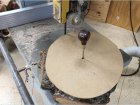I've got a question that I could use some help on. And sorry in advance if this may be a little long. I have turned lots of pens, peppermills, ornaments and a few other things over the years. I thought I'd like to try turning some bowls or something from some logs. There are about a dozen logs that are about 6-10 inches in diameter and two feet or so long from a Siberian Elm tree that was cut down a couple years ago. They have been laying on a crushed rock (1-2" pieces) surface with some on top of each other. Most of the rest of the tree went into firewood. The logs do have large cracks in the ends and most of the bark has either fallen off or is loose on the log. The tree had been standing dead for a couple years before it was cut down so I'm guessing the logs may be fairly dry since the humidity here in Colorado Springs stays pretty low.
I have a Delta midi lathe and several Nova chucks including a midi, G3, and Supernova 2 with assorted jaws. The Supernova can also be used on my Shopsmith as I have both sizes of inserts. I do have a good assortment of spindle and bowl gouges and carbide tools as well. I only have a couple 12" electric chain saws, a sawsall, and a 14" bandsaw to prep the wood. And who knows, what I turn may turn out to be nice pieces. What I would like to know is what size and shape pieces should I cut that would be most beneficial to me?
Roger Petrella
Colorado Springs, CO
I have a Delta midi lathe and several Nova chucks including a midi, G3, and Supernova 2 with assorted jaws. The Supernova can also be used on my Shopsmith as I have both sizes of inserts. I do have a good assortment of spindle and bowl gouges and carbide tools as well. I only have a couple 12" electric chain saws, a sawsall, and a 14" bandsaw to prep the wood. And who knows, what I turn may turn out to be nice pieces. What I would like to know is what size and shape pieces should I cut that would be most beneficial to me?
Roger Petrella
Colorado Springs, CO

